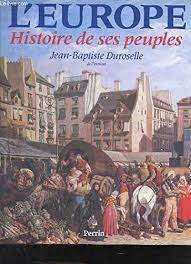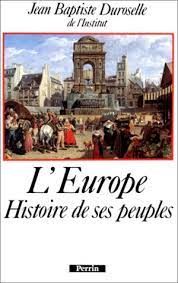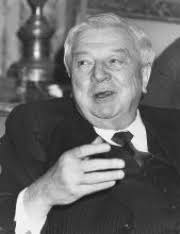Pre-publication of chapter VII of my forthcoming book “Turkey is Iran and Iran is Turkey – 2500 Years of indivisible Turanian – Iranian Civilization distorted and estranged by Anglo-French Orientalists”; chapters VI, VII, VIII, IX and X form Part Three (Turkey and Iran beyond Politics and Geopolitics: Rejection of the Orientalist, Turcologist and Iranologist Fallacies about Achaemenid History) of the book, which is made of 12 parts and 33 chapters. Chapters VIII, IX and X have already been pre-published.
Until now, 20 chapters have been uploaded as partly pre-publication of the present book; this chapter is therefore the 21st (out of 33) to be uploaded. At the end of the text, the entire Table of Contents is made available. Pre-published chapters are marked in blue color, and the present chapter is highlighted in green color.
In addition, a list of all the already pre-published chapters (with the related links) is made available at the very end, after the Table of Contents.
The book is written for the general readership with the intention to briefly highlight numerous distortions made by the racist, colonial academics of Western Europe and North America only with the help of absurd conceptualization and preposterous contextualization.
———————————
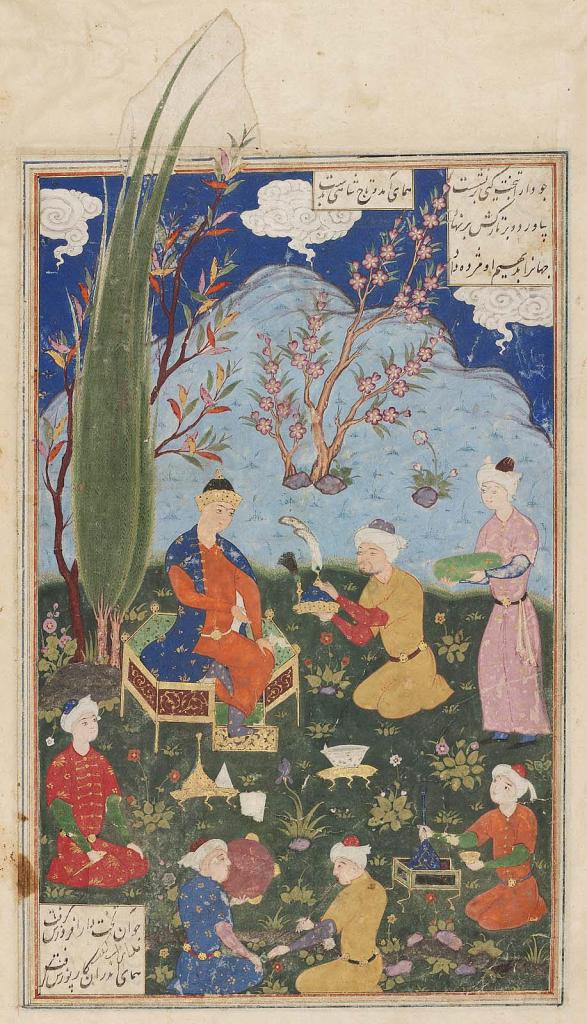
Darius I (named Dara I in Ferdowsi’s Shahnameh) receives his imperial crown from his Mother Humai (from 16th c. manuscript); in the mythical language of the epics, there is no spiritual correspondence to material terms. So, in this regard, Darius I’s mother in the epic has nothing to do with the Achaemenid Shah’s physical mother. And this makes the great difference: whereas worthless colonial Western academics spent volumes of ink and incredible quantities of electronic waste to analyze Darius I’s imperial lineage and his rise to the throne, the simple Iranians knew the absolute truth as to how and why he rose to power: his spiritual Mother Humai brought to him the crown. Now, what spiritual epics and symbolic narratives mean and how they are written are entirely different and vast topics that would take very long to explain here. All the same, colonial academics and Western materialistic historians failed to even attempt to duly analyze these crucial matters, although they knew that Shahnameh constituted the undeniable foundation of Iranian History for all Iranians until the beginning of the 20th c. They disregarded these topics entirely, while absurdly and heinously removing Ferdowsi’s Shahnameh and many other masterpieces of Iranian-Turanian spiritual epics from the corpus of sources of Iranian History.
The Orientalist, Turcologist and Iranologist fallacies reach a culminating point with the study of the 1st millennium BCE Mesopotamia, Iran, Anatolia and Central Asia. The epicenter of the Orientalist distortion is the History of the Achaemenid dynasty of Iran (550-330 BCE). This dynasty proved to be the central period of World History between the Oriental Antiquity (Sumer, Elam, Akkad, Assyria, Babylonia, Hittite Anatolia, Canaan, Egypt, Cush, Punt, the African Atlas, and China) and the Christian – Islamic times. Because of this fact, the multifaceted distortions of Achaemenid History had indeed far reaching consequences and implications.
And truly, the misrepresentation of the world’s greatest civilization and foremost imperial superpower of the middle of the 1st millennium BCE is instrumental in concealing the historical truth, generating overwhelming confusion, fabricating an unprecedented alteration of the Ancient History of the Orient, and producing a totally false and unrepresentative division of the World History, namely Antiquity – Middle Ages – Modern Times.
There are several patterns of historical–linguistic distortion that are always easy for forgers to apply. One of them involves the fabrication of an otherwise nonexistent concept or supposed entity and the preposterous effort to link to it various existent data, known pieces of info, and real elements. Similarly, you fabricate a counterfeit concept, supposedly at the antipodes of the first. In this manner, you effectively manage to produce in reality two nonexistent concepts or entities that you portray as ‘strikingly different from one another’ and you link to each of these two entities many other known pieces of info and various existent data, thus promptly and comfortably generating a division, which in reality does not exist.
This pattern involves therefore postulating, theorizing, and then adding masses of data to the fabricated but non-confirmed, hypothetical schemes. In this regard, by creating a nonexistent Proto-Indo-European and by dogmatically and arbitrarily attaching to it the totality of the vocabulary attested in Old Achaemenid Iranian inscriptions, Western Orientalists attempted to intentionally disburden every Turkic word that can be identified in the Old Achaemenid cuneiform texts. About:
https://en.wikipedia.org/wiki/Proto-Indo-European_language
https://en.wikipedia.org/wiki/Proto-Indo-Europeans
https://en.wikipedia.org/wiki/Proto-Turkic_language
https://en.wikipedia.org/wiki/Turkic_peoples
Actually, the colonial Orientalists did not start the falsification of Iranian History with the misrepresentation of the Achaemenid dynasty; they ended up there! They started their forgery with a much later historical period for which they had abundant texts; and they did not start the systematic disfigurement of the historical reality with historical texts and inscriptions but with epics and literature. They misinterpreted Ferdowsi’s references to Iran and to Turan within his enormous – Iranian and Turanian – epic, the Shahnameh.
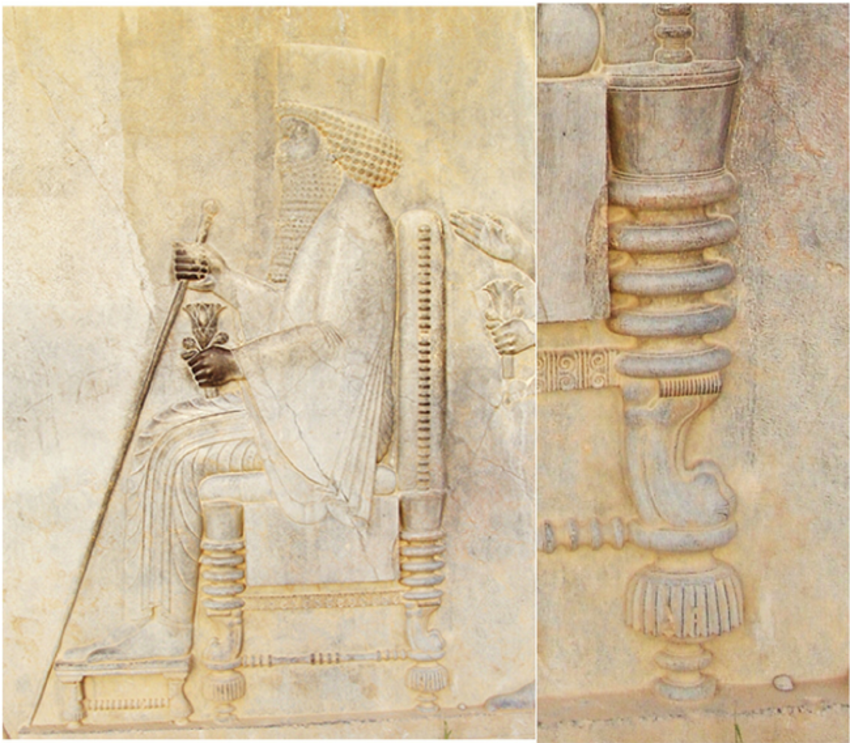
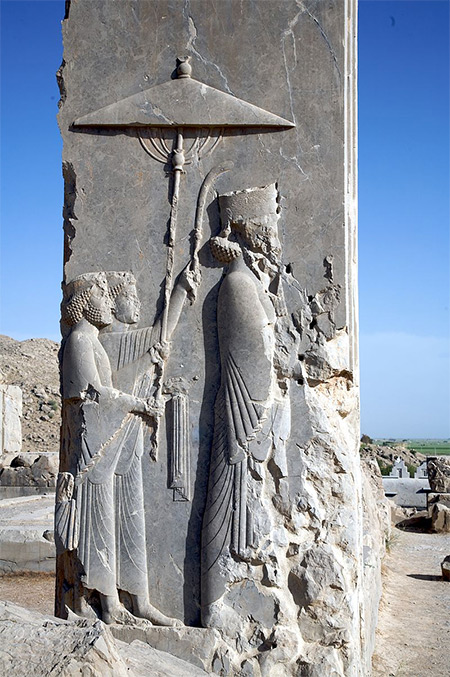
Darius I the Great (above) & Xerxes I the Great (below) depicted on bas-reliefs-Persepolis What Western Orientalists failed to understand is not just an array of monuments or a number of ancient texts; they failed to realize the phenomenon of life and the genius of an atemporal civilization in which the past, the present and the future are all intermingled thanks to masterfully elaborated oral traditions, which fully encapsulates in mythical (i.e. in the only worthwhile) terms the totality of Human History, thus preserving the real essence of the facts and the true knowledge of History. But this essence cannot be perceived by the absurd, mentally defective, rationalist minds of the Western academics, who stick to the surface of the events, merely projecting their naïve and failed perception of the world onto the minds of the ancient constructors of monuments, authors of imperial texts, and artists. In fact, this entire attempt is as dead as a museum; there is no life to it. Unfortunately, it does not help us understand; it prevents any sort of genuine comprehension instead.
What happens in reality is simple; one day, the emperor dies, the empire falls, the palace is demolished, and the texts are burned and destroyed. The details of the deeds, the sequence of the acts, and the order of the decisions are lost. Their secrets vanish and their plans are no more. But the truth stays. It is not in the remaining ruins, and it cannot be found in unearthed statues and deciphered texts; all this is dead, even after we excavate, restore and make it available to visitors. The truth is the life that these people lived; it encompassed their spirituality, piety, imagination, energy, creativity, commitment to rightful choices, efforts and targets. Nothing of all this died; it consists in an enormous but serene, inalienable and ineradicable context of spiritual vibrations, conscious pulsations, subliminal oscillations, olfactory undulations, sound reverberations, and iridescent fluctuations.
This invariable reality can be accessed by any skilled spiritual master and moral mystic with due respect to the specific location and the unequivocal space of time; he can then reconstitute the living image of those lost days, the quintessence of the facts, and the transparence of the spiritual, sentimental and mental consciousness of the main factors (kings, knights, priests, soldiers, heroes, etc.) by means of mythical verses which, being packed with symbols, represent the never lost life of those days in a most vivacious manner to posterity. However, with the above example, I don’t suggest that the arrival of a mystical poet or a spiritual master able to bring about the perfect reflection of the past is compulsory or necessary. All the (average) people had significant spiritual power in the past; they could therefore preserve the living image of the past days as a poem, legend, series of fables or other forms of oral literature and tradition. There is no difference between societies with strong oral tradition and communities accustomed to keeping written records. It is only part of the racism, the monstrosity, and the bias of the Western World that colonial intellectuals and academics pretend that societies with written records are ‘more civilized’ than the rest.
What does all this mean?
It simply means that, wherever the mythical language was preserved among a traditional, moral and pious society, and the local spiritual epics, the legendary traditions, and the heroic fables of universal character were highly valued and cherished, the traditional narrative and the related depiction in a manuscript miniature are definitely closer to the true historical reality than the ancient reliefs and the texts which have been excavated and deciphered. In brief, the very first picture included in this document, although it dates back to the 16th c., represents the spiritual and material life of Darius I better than the bas relief from Persepolis (second picture in the present document). Despite the fact that the bas relief dates back to the reign of Darius I whereas the manuscript was written and decorated more than 2000 years later, the miniature offers a truer and more vivacious reflection of life around Darius I.
———————————————–
Shahnameh constituted for more than 900 years the true Iranian History that Iranians and Turanians cherished and respected; disreputable Western bogus-scholars started describing this epic as ‘chivalrous’, either because they failed to deeply understand it or due to their materialistic preconceived ideas and anti-heroic misery and savagery.
Writing his majestic (more than 100000 verses in Farsi) epic, which is the world’s largest ever, in the late 10th and the early 11th c., Ferdowsi presented a dynamic interaction between Iran and Turan across ages. The intertwined relationship of Iran and Turan generated all major historical developments and in the process, it literally produced the human civilization; this is the essence of Ferdowsi’s monumental and phenomenal narrative, which is of course rendered in a highly spiritual, mythical and symbolic manner. The imperial families of Iran and Turan were evidently interlinked with mixed marriages across Ferdowsi’s masterpiece, which is the World History’s unsurpassed pivot of spirituality and civilization. In his foremost universal and Universalist epic, Ferdowsi created also an archetypal environment of moral clash between two realms: the world of good, enlightened, orderly and civilized Iran and the threatening periphery of evil, tenebrous, chaotic and barbarian Aniran. In fact, Aniran means “the Non-Iran”. But Aniran has nothing to do with Turan, which is alternating with Iran, being intertwined with it, as I already said.
The above is not my conclusion or my opinion; it is the historical reality. It consists in the most accurate and most pertinent interpretation made available in symbolic (not rationalist) terms within the world’s most illustrious epics. If Iran and Turan were opponent inimical and prejudicial to one another, Iranian culture would never be wholeheartedly shared by Turanians, because it would be viewed as defamatory and loathsome. If Turan and Iran were opposite, inimical and prejudicial to one another, Turanian culture would never be wholeheartedly accepted by major Iranian poets, mystics, spiritual masters, writers, scholars and emperors. But we know that such things did not happen; we know very well that Iranian kings and emperors of the Islamic times spoke in Turkic languages to their soldiers and that Turanian kings and emperors of the Islamic times wrote, memorized and recited verses of the Iranian epic poetry in Farsi.
We know that historically in the minds of all Turanians and Iranians there was no concept of opposition between Iran and Turan, because in reality, and as I already said, the two terms alternate in an everlasting dialectical relationship in order to shape World History. It is herewith worthwhile to mention as example that, prior to the Battle at Chaldiran (1514), Selim I in his letter to Ismail I (which was written in Farsi) described himself, although being an Ottoman, as ‘Fereydun’, namely a fully accredited and highly revered Iranian hero and king of the Pishdadian dynasty, the first family of divine rulers who originated from Keyumars (Adam). Had there been any sense of enmity, animosity, rivalry or strife between Iran and Turan, among Iranians and Turanians, between Iranian culture and Turanian culture, this would not have happened. About:
Click to access 02selimismail.pdf
https://www.fas.nus.edu.sg/hist/eia/documents_archive/selim.php https://m.blog.naver.com/PostView.nhn?blogId=sohwa117&logNo=220775015217&proxyReferer=https:%2F%2Fwww.google.ru%2F
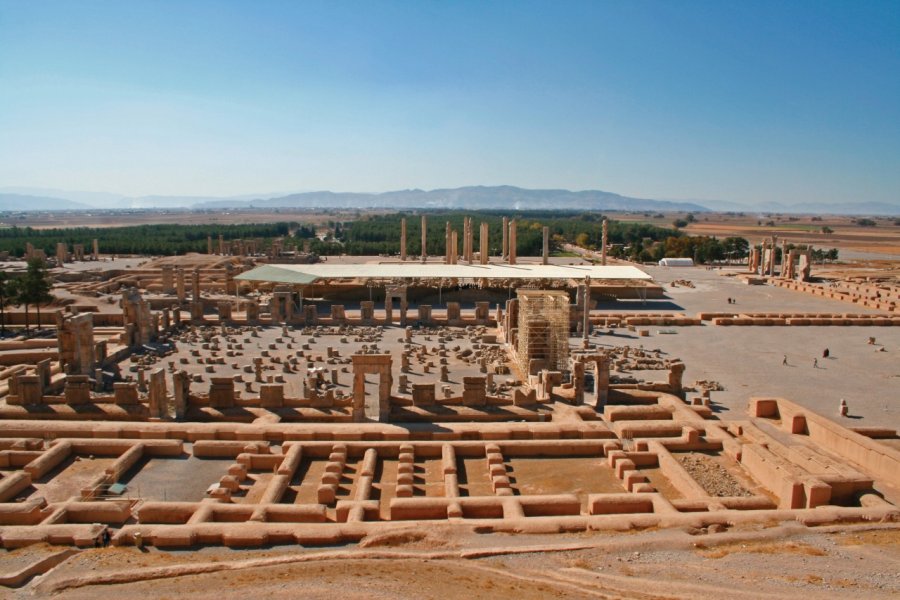
Parsa (Persepolis), the great Achaemenid capital; few Western Iranologists bothered to examine why this vast, majestic and solemn location is named Takht-e Jamshid in the Iranian folk traditions and popular culture. They certainly know that in various regions of Asia and Africa, Muslims named numerous places after several persons of the Biblical and Quranic traditions; they also know that in all the lands that had been impacted by the Iranian-Turanian civilization, this tendency further encompasses the distinct religious forms of Zoroastrianism before and after the arrival of Islam. However, their expertise ends there and they have a very confused opinion about, and understanding of, the interconnection between the Iranian literary epic tradition (such as Ferdowsi’ Shahnameh) and the Iranian popular religion.
They thus fail to identify pre-Islamic mystical traditions that were kept in various forms of popular culture and, amongst others, impacted great poets and mystics like Ferdowsi, Nezami Ganjavi, Amir Khusraw, and others. But the Iranian popular religion is an entirely independent body of concepts, faiths, values, and narratives out of which emanate countless Iranian folk traditions and the popular culture.
The appellation ‘Takht-e Jamshid’ is not due to Ferdowsi or any other poet’s ‘Shahnameh’ but represents a genuine expression of the Iranian-Turanian nations’ folk traditions. Ferdowsi only helps us fathom the awesome heights to which the popular culture, fully preserving Achaemenid mysticism, catapulted the location of Persepolis: the Throne (Takht-e) of Jamshid, as description of the Achaemenid capital, makes of the place the epicenter of the divine rule (‘throne’) of the third descendant of Adam (Keyumars). This transcendental reality explains why Darius I transferred the capital from Pasargad (Pasargadae) and had the majestic site constructed. Now, when you ask yourself “why Takht-e Jamshid, and not Takht-e Zahhak or Takht-e Fereydun?” (referring to two other legendary figures who were respectively the son and the grandson of Jamshid), you come face to face with all the hitherto unanswered colossal questions of the Iranian spirituality, popular religion, and folk traditions that even Ferdowsi and Nezami Ganjavi failed to properly make. Introductory data (not correct analysis), you can find here:
https://en.wikipedia-on-ipfs.org/wiki/Pishdadian_dynasty https://en.wikipedia.org/wiki/Pishdadian_dynasty
https://en.wikipedia.org/wiki/Jamshid
https://en.wikipedia.org/wiki/Persepolis
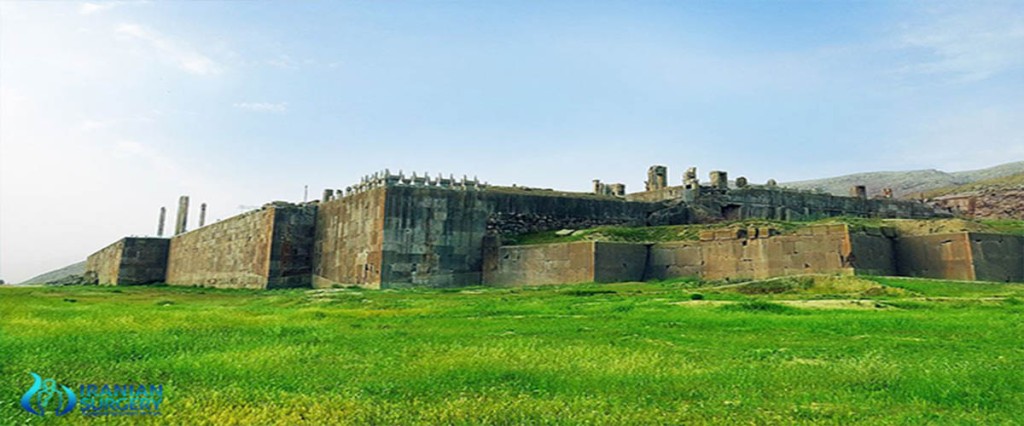
I don’t want to expand more here, because I am only making a flash-forward while speaking about the Achaemenid times; I therefore want only to indicate the sources from which the evil colonial scholars first got the knowledge and second discredited the sources in order to deprive hundreds of millions of Iranians and Turanians of the historical truth, the cultural integrity, the national identity, and the transcendental wisdom that they had for millennia.
Subsequently, the criminal colonial scholars of England, France, America, Canada, etc. malignantly invented the ahistorical and fake ‘Iran – Turan’ divide, which they later projected onto their deliberately falsified reading of Achaemenid History. I will further discuss this Orientalist distortion in other chapters, but at this point I want to underscore the alternating nature of the two terms; this means that in fact Iran is Turan and Turan is Iran.
People should also bear also in mind that the historical-geographical terms do not apply literally in transcendental epics like Ferdowsi’s Shahnameh! Quite contrarily, everything takes a symbolic connotation and dimension, and you cannot apply terms like “Iran” and “Turan” in the manner many do nowadays, separating Iran from Turkic-speaking Central Asiatic states. All this is meaningless in Ferdowsi.
To give you an example, when the great atemporal hero Fereydun leaves Iran and goes far to find the Sublime Key Qubad and drive him to Iran where he is called to become the King of Kings, Fereydun goes merely to Alborz Mountains! In the simple geographical connotation of the term, these mountains separate Tehran from the Caspian Sea shore in today’s Iran. But as I pointed out, “historical-geographical terms do not apply literally in transcendental epics”. About (I include the links below only indicatively, because most of the contents are erroneous):
https://en.wikipedia.org/wiki/Alborz
https://en.wikipedia.org/wiki/Kayanian_dynasty
https://en.wikipedia.org/wiki/Kay_Kaw%C4%81d
https://en.wikipedia.org/wiki/Fereydun
https://en.wikipedia.org/wiki/Ferdowsi
https://en.wikipedia.org/wiki/Shahnameh
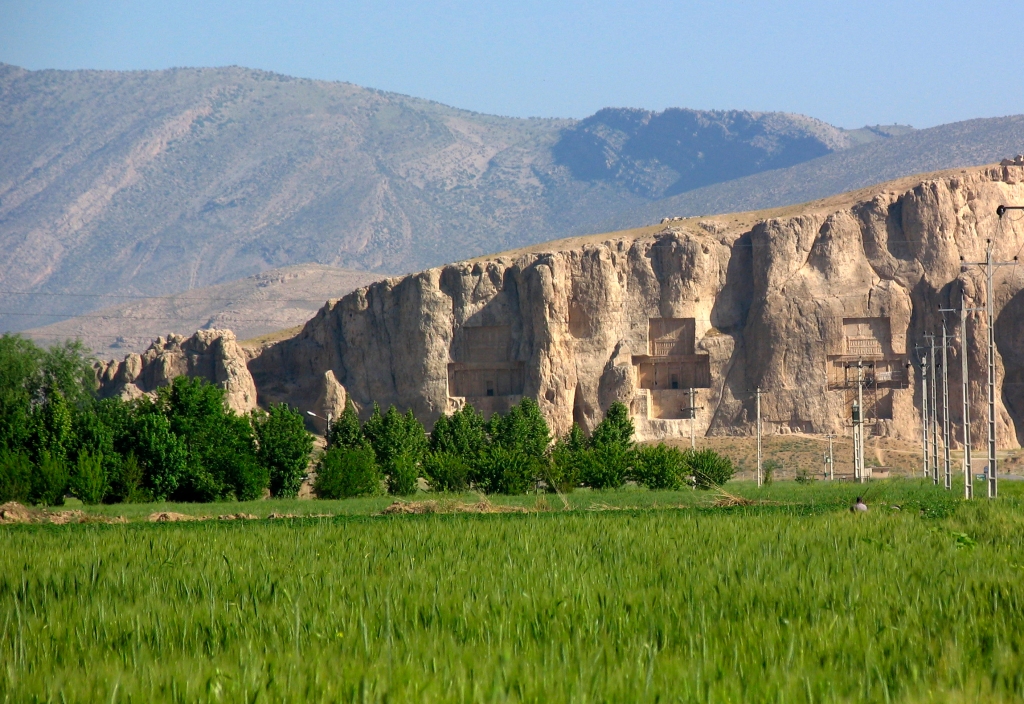
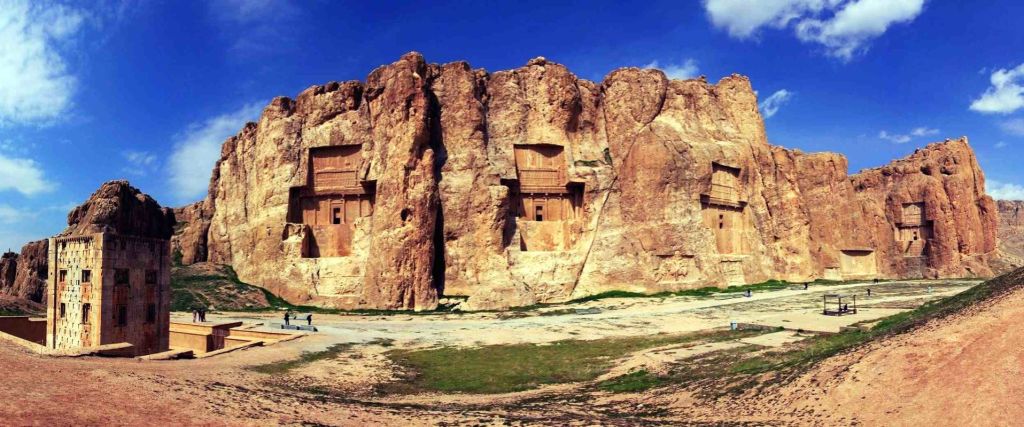
At a distance of about 7 km from Takht-e Jamshid – Parsa (Persepolis) stands the Imperial Achaemenid necropolis: the majestic cruciform tombs of Darius I, Xerxes I, Artaxerxes I and Darius II are hewn in a rocky mountain. Less spectacular but undeniably very remarkable monuments (bas-reliefs, inscriptions, edifices, etc.) from later periods (notably Sassanid) can also be found in the superb location, which is named Naqsh-e Rustam, i.e. ‘the Image of Rustam’. Being the son of the mythical king Zal and the princess of Kabul Rudaba, Rustam is one of the greatest heroes and most paramount fighters of the Iranian popular religion and epic literature. But he markedly lives at the end of the Pishdadian and the early Kayanian dynasties, so certainly ‘later’ than Fereydun and much later than Jamshid.
For all those who fail to strictly apply spiritual, transcendental and atemporal values and standards to every form of creativity attested within the Iranian folk traditions and popular religion, there is a very simple question:
– Why is the location of the Achaemenid tombs related to another mythical king and hero (Rustam) than the place where the same Achaemenid royals (Darius I, Xerxes I, Artaxerxes I, Darius II) reigned (Parsa / Persepolis), which is associated with a much earlier hero (Jamshid)?
Also:
– In what sense is an imperial palace described as a throne (‘takht’) but a tomb is called ‘the image’ (Naqsh) of a hero?
In any case, concerning Naqsh-e Rustam, many leading Iranologists make the terrible mistake to associate the term ‘naqsh’ (image) with the Sassanid bas reliefs. This must have been so blasphemous if said during the Sassanid times! The Sassanid rulers knew the sacrosanct significance of the location; they were honored to be represented there too. But the divine benediction belonged to earlier times.
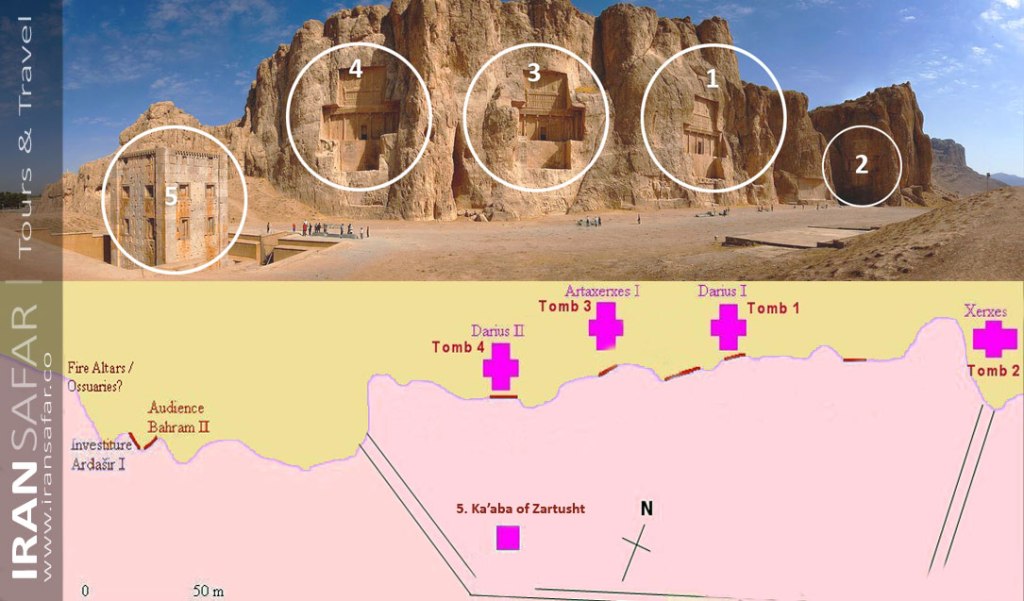
So, the early Orientalists, who were 18th and 19th c. colonial explorers, antiquarians, adventurers, agents of secret services, and diplomats, transfigured the meaning of Ferdowsi’s text and altered the symbolic terms used in the epics according to their own interests. They therefore first made the equation “Turan equals Aniran”, and they subsequently misinterpreted the majestic Iranian epic, which was believed as the ‘true History of Iran and Aniran’, reducing it to untrustworthy legendary stories that could not be taken into account their forged historiography.
Furthermore, the Western scholars projected this fictional, unsubstantiated and nonexistent polarization onto all parts of ‘Iranian History’ (pre-Islamic and Islamic), presenting Iranian emperors and Iranian culture as diametrically opposed to the Turkic emperors and to Turanian (or Turkic) culture. At the end, they also attempted to reflect their fake divide within the context of the Achaemenid times, a historical period for which the earliest existing documentation was mainly the untrustworthy, partial and external Ancient Greek historical sources.
Not only had the Western colonial scholarship failed to apply serious criticism to the highly biased and evidently racist Ancient Greek sources, but they also proved to be unwilling to duly popularize among Iranians and worldwide the Old Achaemenid sources after they were deciphered. Early excavations were resumed in Iran during the 19th and the early 20th c., only for the overwhelming Orientalist campaign of systematic distortion of ‘Ancient Iran’ to start.
In other words, the absurd, miserable and lowly Western scholars deprived the greatest nation of Asia (Iranians and Turanians) of their true, vivacious, sagacious, and transcendental History and they forced them to learn the Ancient Greek racist lies that the silly Pahlavi dictators and the stupid Islamist politicians proved equally unable to refute in public.
Beyond the fabrication of nonexistent concepts, entities, and schemes, other patterns of distortion revolve around a) polarization between non-opposite elements, b) systematic purification of a historical period, culture or civilization from undesired elements, and c) extrapolation from the forged past to the reconstructed present.
——————————————————–
FORTHCOMING
Turkey is Iran and Iran is Turkey
2500 Years of indivisible Turanian – Iranian Civilization distorted and estranged by Anglo-French Orientalists
By Prof. Muhammet Şemsettin Gözübüyükoğlu
(Muhammad Shamsaddin Megalommatis)
TABLE OF CONTENTS
PREFACE
CONTENTS
PART ONE. INTRODUCTION
CHAPTER I: A World held Captive by the Colonial Gangsters: France, England, the US, and the Delusional History Taught in their Deceitful Universities
A. Examples of fake national names
a) Mongolia (or Mughal) and Deccan – Not India!
b) Tataria – Not Russia!
c) Romania (with the accent on the penultimate syllable) – Not Greece!
d) Kemet or Masr – Not Egypt!
e) Khazaria – not Israel!
f) Abyssinia – not Ethiopia!
B. Earlier Exchange of Messages in Turkish
C. The Preamble to My Response
CHAPTER II: Geopolitics does not exist.
CHAPTER III: Politics does not exist.
CHAPTER IV: Turkey and Iran beyond politics and geopolitics: Orientalism, conceptualization, contextualization, concealment
A. Orientalism
B. Conceptualization
C. Contextualization
D. Concealment
PART TWO. EXAMPLE OF ACADEMICALLY CONCEALED, KEY HISTORICAL TEXT
CHAPTER V: Plutarch and the diffusion of Ancient Egyptian and Iranian Religions and Cultures in Ancient Greece
PART THREE. TURKEY AND IRAN BEYOND POLITICS AND GEOPOLITICS: REJECTION OF THE ORIENTALIST, TURKOLOGIST AND IRANOLOGIST FALLACIES ABOUT ACHAEMENID HISTORY
CHAPTER VI: The fallacy that Turkic nations were not present in the wider Mesopotamia – Anatolia region in pre-Islamic times
CHAPTER VII: The fallacious representation of Achaemenid Iran by Western Orientalists
CHAPTER VIII: The premeditated disconnection of Atropatene / Adhurbadagan from the History of Azerbaijan
CHAPTER IX: Iranian and Turanian nations in Achaemenid Iran
CHAPTER X: Iranian and Turanian Religions in Pre-Islamic Iran
PART FOUR. FALLACIES ABOUT THE SO-CALLED HELLENISTIC PERIOD, ALEXANDER THE GREAT, AND THE SELEUCID & THE PARTHIAN ARSACID TIMES
CHAPTER XI: Alexander the Great as Iranian King of Kings, the fallacy of Hellenism, and the nonexistent Hellenistic Period
CHAPTER XII: Parthian Turan: an Anti-Persian dynasty
CHAPTER XIII: Parthian Turan and the Philhellenism of the Arsacids
PART FIVE. FALLACIES ABOUT SASSANID HISTORY, HISTORY OF RELIGIONS, AND THE HISTORY OF MIGRATIONS
CHAPTER XIV: Arsacid & Sassanid Iran, and the wars against the Mithraic – Christian Roman Empire
CHAPTER XV: Sassanid Iran – Turan, Kartir, Roman Empire, Christianity, Mani and Manichaeism
CHAPTER XVI: Iran – Turan, Manichaeism & Islam during the Migration Period and the Early Caliphates
PART SIX. FALLACIES ABOUT THE EARLY EXPANSION OF ISLAM: THE FAKE ARABIZATION OF ISLAM
CHAPTER XVII: Iran – Turan and the Western, Orientalist distortions about the successful, early expansion of Islam during the 7th – 8th c. CE
CHAPTER XVIII: Western Orientalist falsifications of Islamic History: Identification of Islam with only Hejaz at the times of the Prophet
CHAPTER XIX: The fake, Orientalist Arabization of Islam
CHAPTER XX: The systematic dissociation of Islam from the Ancient Oriental History
PART SEVEN. THE FICTIONAL DIVISION OF ISLAM INTO ‘SUNNI’ AND ‘SHIA’
CHAPTER XXI: The fabrication of the fake divide ‘Sunni Islam vs. Shia Islam’
PART EIGHT. THE DISTORTED TERM ‘PERSIANATE’
CHAPTER XXII: The fake Persianization of the Abbasid Caliphate
PART NINE. FALLACIES ABOUT THE GOLDEN ERA OF THE ISLAMIC CIVILIZATION
CHAPTER XXIII: From Ferdowsi to the Seljuk Turks, Nizam al Mulk, Nizami Ganjavi, Jalal ad-Din Rumi and Haji Bektash
PART TEN. FALLACIES ABOUT THE TIMES OF TURANIAN (MONGOLIAN) SUPREMACY IN TERMS OF SCIENCES, ARTS, LETTERS, SPIRITUALITY AND IMPERIAL UNIVERSALISM
CHAPTER XXIV: From Genghis Khan, Nasir al-Din al Tusi and Hulagu to Timur
CHAPTER XXV: Timur (Tamerlane) as a Turanian Muslim descendant of the Great Hero Manuchehr, his exploits and triumphs, and the slow rise of the Turanian Safavid Order
CHAPTER XXVI: the Timurid Era as Peak of the Islamic Civilization, Shah Rukh, and Ulugh Beg, the Astronomer Emperor
PART ELEVEN. HOW AND WHY THE OTTOMANS, THE SAFAVIDS AND THE MUGHALS FAILED
CHAPTER XXVII: Ethnically Turanian Safavids & Culturally Iranian Ottomans: two identical empires that mirrored one another
CHAPTER XXVIII: Spirituality, Religion & Theology: the fallacy of the Safavid conversion of Iran to ‘Shia Islam’
CHAPTER XXIX: Selim I, Ismail I, and Babur
CHAPTER XXX: The Battle of Chaldiran (1514), and how it predestined the Fall of the Islamic World
CHAPTER XXXI: Ottomans, Safavids and Mughals: victims of their sectarianism, tribalism, theology, and wrong evaluation of the colonial West
CHAPTER XXXII: Ottomans, Iranians and Mughals from Nader Shah to Kemal Ataturk
PART TWELVE. CONCLUSION
CHAPTER XXXIII: Turkey and Iran beyond politics and geopolitics: whereto?
—————————————————
List of the already pre-published chapters of the book
Lines separate chapters that belong to different parts of the book.
CHAPTER VIII: The premeditated disconnection of Atropatene / Adhurbadagan from the History of Azerbaijan
CHAPTER IX: Iranian and Turanian nations in Achaemenid Iran
https://www.academia.edu/105880180/Iranian_and_Turanian_nations_in_Achaemenid_Iran
CHAPTER X: Iranian and Turanian Religions in Pre-Islamic Iran
https://www.academia.edu/105664696/Iranian_and_Turanian_Religions_in_Pre_Islamic_Iran
—————————-
CHAPTER XI: Alexander the Great as Iranian King of Kings, the fallacy of Hellenism, and the nonexistent Hellenistic Period
CHAPTER XII: Parthian Turan: an Anti-Persian dynasty
https://www.academia.edu/52541355/Parthian_Turan_an_Anti_Persian_dynasty
CHAPTER XIII: Parthian Turan and the Philhellenism of the Arsacids
https://www.academia.edu/105539884/Parthian_Turan_and_the_Philhellenism_of_the_Arsacids
———————————
CHAPTER XIV: Arsacid & Sassanid Iran, and the wars against the Mithraic – Christian Roman Empire
CHAPTER XV: Sassanid Iran – Turan, Kartir, Roman Empire, Christianity, Mani and Manichaeism
CHAPTER XVI: Iran – Turan, Manichaeism & Islam during the Migration Period and the Early Caliphates
———————————-
CHAPTER XVII: Iran–Turan and the Western, Orientalist distortions about the successful, early expansion of Islam during the 7th-8th c. CE
CHAPTER XIX: The fake, Orientalist Arabization of Islam
https://www.academia.edu/105713891/The_fake_Orientalist_Arabization_of_Islam
CHAPTER XX: The systematic dissociation of Islam from the Ancient Oriental History
—————————————
CHAPTER XXI: The fabrication of the fake divide ‘Sunni Islam vs. Shia Islam’
https://www.academia.edu/55139916/The_Fabrication_of_the_Fake_Divide_Sunni_Islam_vs_Shia_Islam_
——————————————
CHAPTER XXII: The fake Persianization of the Abbasid Caliphate
https://www.academia.edu/61193026/The_Fake_Persianization_of_the_Abbasid_Caliphate
——————————————–
CHAPTER XXIII: From Ferdowsi to the Seljuk Turks, Nizam al Mulk, Nizami Ganjavi, Jalal ad-Din Rumi and Haji Bektash
————————————————
CHAPTER XXIV: From Genghis Khan, Nasir al-Din al Tusi and Hulagu to Timur
CHAPTER XXV: Timur (Tamerlane) as a Turanian Muslim descendant of the Great Hero Manuchehr, his exploits and triumphs, and the slow rise of the Turanian Safavid Order
CHAPTER XXVI: The Timurid Era as the Peak of the Islamic Civilization: Shah Rukh, and Ulugh Beg, the Astronomer Emperor
—————————————–
CHAPTER XXVII: Ethnically Turanian Safavids & Culturally Iranian Ottomans: two identical empires that mirrored one another
CHAPTER XXVIII: Spirituality, Religion & Theology: the fallacy of the Safavid conversion of Iran to ‘Shia Islam’
————————————————————–
Download the chapter (text only) in PDF:
Download the chapter (pictures & legends) in PDF:





















